
Sempervivum is a genus of about 40 species of flowering plants in the family Crassulaceae, commonly known as houseleeks. Other common names include liveforever and hen and chicks, a name shared with plants of other genera as well. They are succulent perennials forming mats composed of tufted leaves in rosettes. In favourable conditions they spread rapidly via offsets, and several species are valued in cultivation as groundcover for dry, sunny locations.

Saxifraga is the largest genus in the family Saxifragaceae, containing about 473 species of holarctic perennial plants, known as saxifrages or rockfoils. The Latin word saxifraga means literally "stone-breaker", from Latin saxum + frangere. It is usually thought to indicate a medicinal use for treatment of urinary calculi, rather than breaking rocks apart.
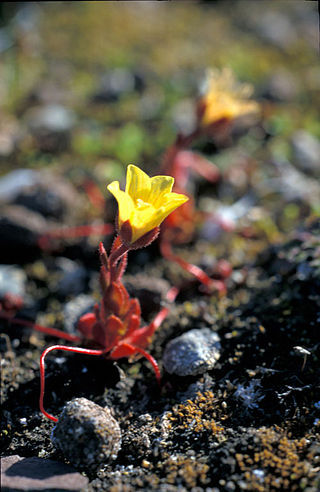
Saxifraga flagellaris, the whiplash saxifrage or flagellate saxifrage, is a plant native all over the Eurasian Arctic Coast, Siberia, Far East, Caucasus and some areas of northern Rocky Mountains. It is not very common. It is also known as spider saxifrage or "spider plant", though the latter name more commonly refers to the unrelated Chlorophytum comosum (Agavaceae).

Saxifraga × urbium, London pride, is an evergreen perennial garden flowering plant. Alternative names for it include St. Patrick's cabbage, whimsey, prattling Parnell, and look up and kiss me. Before 1700 the “London pride” appellation was given to the Sweet William.
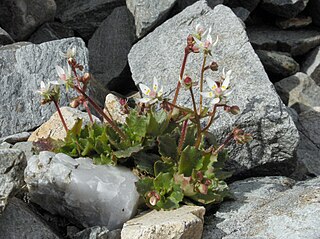
Micranthes stellaris, synonym Saxifraga stellaris, the starry saxifrage or hairy kidney-wort, is an Arctic–alpine species in the family Saxifragaceae. It produces panicles of 5–10 white flowers on a stem up to 20 cm (7.9 in) tall, rising from a basal leaf rosette. One subspecies is found from eastern Canada to Russia, including the British Isles, while another is found in the mountains of southern Europe.

Saxifraga stolonifera is a perennial flowering plant known by several common names, including creeping saxifrage, strawberry saxifrage, creeping rockfoil, Aaron's beard, mother of thousands, roving sailor, and strawberry begonia or strawberry geranium.

Saxifraga cotyledon, the pyramidal saxifrage, occurs in the mountains of Europe and has rosettes about 20 centimetres (8 in) across of tongue-shaped leaves, beaded but not toothed. In May or June the tall panicles of white flowers, branched and pyramidal in outline, may reach 60 cm (24 in). It is one of Norway's two national flowers. Its relationship to the "silver saxifrages" remains to be resolved to full satisfaction.

Phlox paniculata is a species of flowering plant in the phlox family (Polemoniaceae). It is native to parts of the eastern and central United States. It is extensively cultivated in temperate regions as an ornamental plant and has become established in the wild in scattered locales in other regions. Common names include fall phlox, garden phlox, perennial phlox, summer phlox, and panicled phlox.

Micranthes nivalis is a plant species in the saxifrage family. It is commonly called snow saxifrage or (ambiguously) alpine saxifrage.

Erysimum cheiri, syn. Cheiranthus cheiri, the wallflower, is a species of flowering plant in the family Brassicaceae (Cruciferae), native to Greece, but widespread as an introduced species elsewhere. It is also treated as a hybrid under the name Erysimum × cheiri. It is widely cultivated as a garden plant.

Hydrangea paniculata, or panicled hydrangea, is a species of flowering plant in the family Hydrangeaceae native to southern and eastern China, Korea, Japan and Russia (Sakhalin). It was first formally described by Philipp Franz von Siebold in 1829.

Saxifraga aspera is a species of saxifrage known by the common name of rough saxifrage. In German it is known as Rauhhaariger Steinbrech. It is placed in section Trachyphyllum of the genus Saxifraga. There are two subspecies, Saxifraga aspera subsp. aspera and Saxifraga aspera subsp. micrantha. It is a plant of the pan-Arctic tundra and is also found in Europe at moderately high altitudes in the Alps, Pyrenees and northern Apennines.

Saxifraga globulifera is a flowering plant of the genus Saxifraga and the family Saxifragaceae.

Polygala calcarea, the chalk milkwort, is a species of flowering plant in the family Polygalaceae, native to western Europe. It is a delicate mat-forming evergreen perennial growing to 5 cm (2 in) tall by 20 cm (8 in) broad, with spikes of small, vivid deep blue flowers in spring, and leathery, oval leaves.
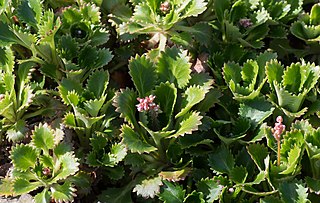
Saxifraga spathularis, the St Patrick's cabbage, is a species of saxifrage native to Ireland, Portugal, and Spain. It is a member of the so-called Lusitanian flora, a small set of plants which are native to Ireland but inexplicably absent from Great Britain. It consists of a basal rosette of elongate obovate succulent leaves around an upright leafless flowering stem. It seems to grow best in humus-rich alpine habitats among acidic rocks. With Saxifraga umbrosa it is a parent of Saxifraga × urbium.
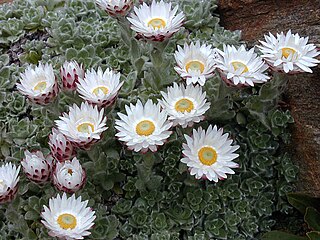
Helichrysum milfordiae, the Milford everlasting, is a species of flowering plant in the family Asteraceae, native to South Africa. Growing to 10 cm (3.9 in) high by 50 cm (20 in) wide, it is a mat-forming evergreen perennial with silver-grey leaves arranged in tight rosettes, producing solitary daisy-like flowers in spring. The white flower bracts have pink undersides which are prominent in bud.

Saxifraga fortunei (齿瓣虎耳草), the fortune saxifrage, is a species of flowering plant in the family Saxifragaceae, native to China, Japan and Korea. Growing to just 40 cm (16 in) tall and broad, it is a shade-loving herbaceous perennial with large round fleshy leaves. Slender branched stalks bear panicles of small white starry flowers in summer. The two lower petals of each bloom are significantly longer than the others. Both the flowers and the leaves are sometimes flushed red or pink.
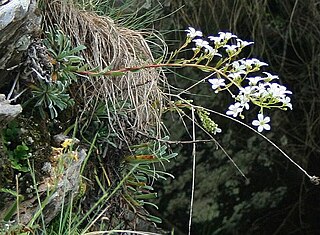
Saxifraga callosa, the limestone saxifrage, is a species of flowering plant in the family Saxifragaceae, that is native to maritime alpine habitats in Western Europe. Growing to 50 cm (20 in) tall by 100 cm (39 in) broad, it is a clump-forming evergreen perennial with rosettes of narrow grey-green leaves that are coated in lime. The starry, pure white flowers are borne in long panicles in spring.
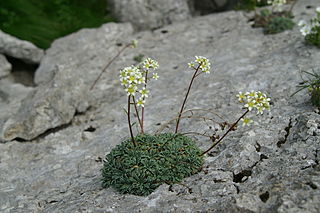
Saxifraga crustata, the crusted-leaved saxifraga and silver saxifrage, as well as encrusted saxifrage, is an evergreen perennial plant species in the family Saxifragaceae, native to the Eastern Alps. This species was described by Austrian botanist Lorenz Chrysanth von Vest in 1804.
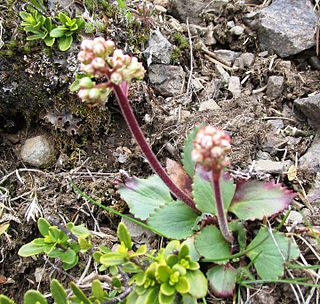
Micranthes occidentalis, commonly known as western saxifrage, is a species of flowering plant native to North America.





















